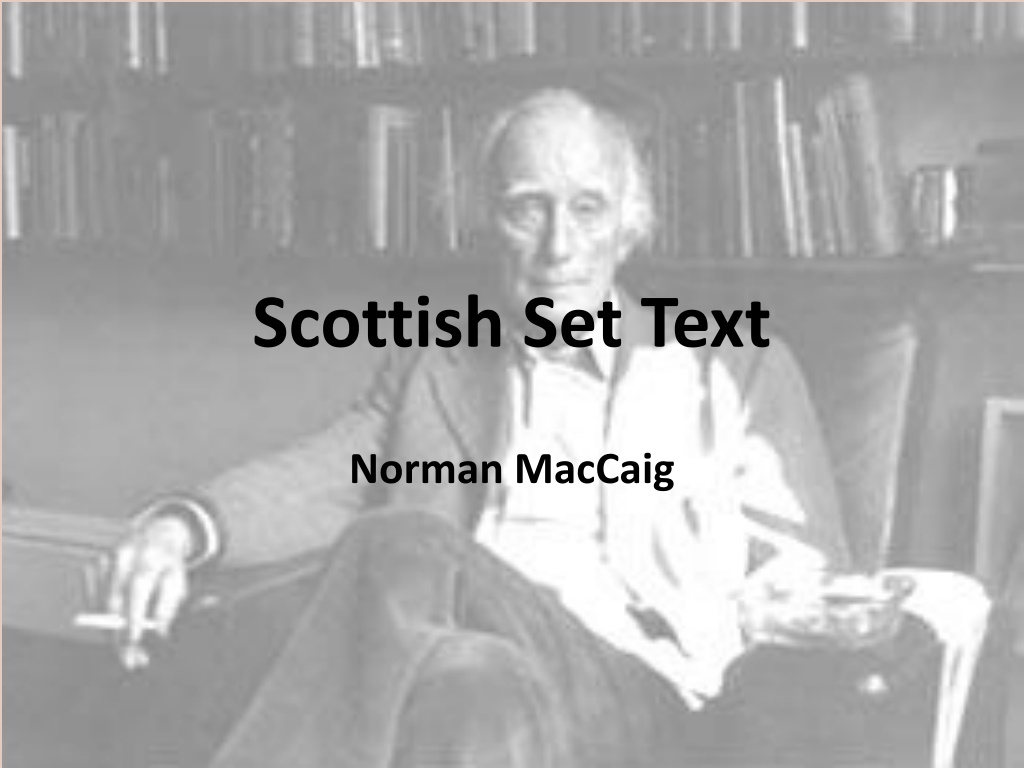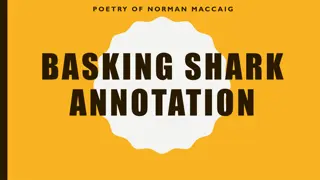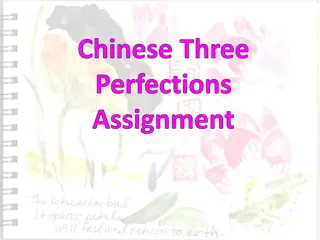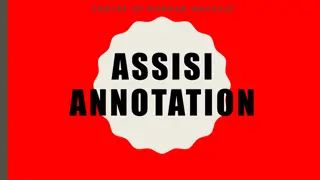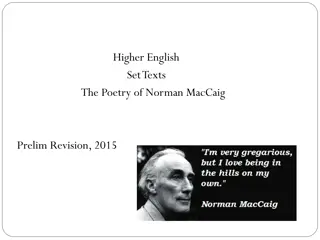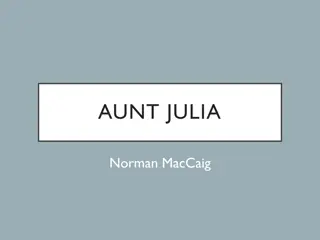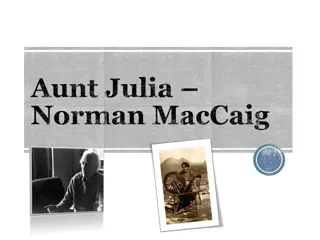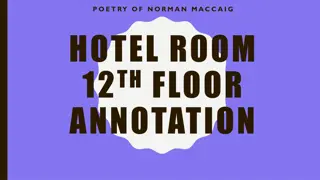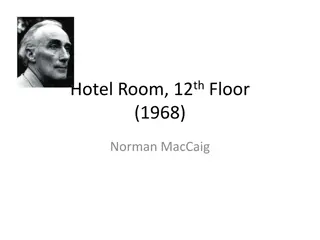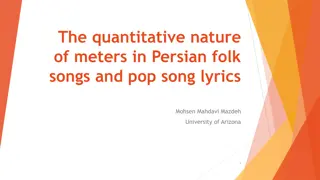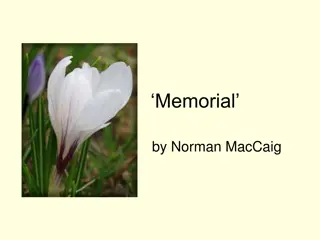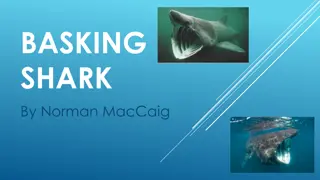Exploring the Life and Poetry of Norman MacCaig
Delve into the world of Scottish poet Norman MacCaig through his iconic works such as "Assisi," "Visiting Hour," and "Aunt Julia." Uncover the essence of his life and poetry, from capturing poignant moments to reflecting on humanity and nature. Engage in a journey of understanding and interpretation of MacCaig's profound literary contributions.
Download Presentation

Please find below an Image/Link to download the presentation.
The content on the website is provided AS IS for your information and personal use only. It may not be sold, licensed, or shared on other websites without obtaining consent from the author. Download presentation by click this link. If you encounter any issues during the download, it is possible that the publisher has removed the file from their server.
E N D
Presentation Transcript
http://www.textualities.net/wp-content/uploads/2008/08/writers/features-h-m/maccaign01pic3.jpghttp://www.textualities.net/wp-content/uploads/2008/08/writers/features-h-m/maccaign01pic3.jpg Scottish Set Text Norman MacCaig
The Scottish Set Texts Norman MacCaig Assisi Visiting Hour Aunt Julia Basking Shark Sounds of the day Memorial Our aim, over the coming months is to study and understand each of these poems
Who is Norman MacCaig? You will each be issued with two biographies written about MacCaig. You have 10 minutes to complete the following task: Skim read both biographies, highlighting the most important points. Write one paragraph that you believe sums up MacCaig s life.
Assisi by Norman MacCaig
Assisi The components of the poem
Assisi The dwarf with his hands on backwards sat, slumped like a half-filled sack on tiny twisted legs from which sawdust might run, outside the three tiers of churches built in honour of St Francis, brother of the poor, talker with birds, over whom he had the advantage of not being dead yet. A priest explained how clever it was of Giotto to make his frescoes tell stories that would reveal to the illiterate the goodness of God and the suffering of His Son. I understood the explanation and the cleverness.
A rush of tourists, clucked contentedly, fluttered after him as he scattered the grain of the Word. It was they who passed the ruined temple outside, whose eyes wept pus, whose back was higher than his head, whose lopsided mouth said Grazie in a voice as sweet as a child's when she speaks to her mother or a bird's when it spoke to St Francis.
Task Time Individual: What did you think the poem was about? Take a minute to consider if you understood the poem. Think about was there anything you liked or disliked about the poem. Pair: Now discuss with your partner what you thought the poem was about. Share your ideas with your partner and write down your answers. This should take a couple of minutes.
The Title - Assisi Does this word ring any bells?
Assisi Assisi is a city in Italy. Famously, it is the home of St. Francis of Assisi. The founder of the Franciscan order of the Friars Minor, Francis emphasised simplicity and poverty. Many of the stories that surround the life of St Francis deal with his selfless charity and love for animals as well as the saint's love of the natural world.
The grandiose, gorgeously embellished Basilica di San Francesco (Chruch of St. Francis) in Assisi is a rather incongruous memorial to a man who preached and lived a simple life of poverty, abstinence, and renunciation of worldly goods in search of greater spirituality.
Inside the Basilica of St. Francis of Assisi its priceless frescos (by the painter Giotto) are a major tourist attraction.
A YouTube clip of the church http://www.youtube.com/watch?v=L_JFZqMFl ws
The Title Where is Assisi?
The Church of Saint Francis of Assisi (in Assisi) File:Lightmatter Basilica of StFrancis Assisi.jpg
Task What is the poem about? 1. In your own words, summarise what is happening in the poem? 2. What do you feel about: a) The beggar b) The priest c) The tourists 3. What kinds of ideas can we draw from MacCaig s poem? (What is his attitude toward the situation?)
Contrast In the poem, MacCaig expresses his distain for the hypocrisy of organised religion. There is a discrepancy between what the tourists are taught and in the way that they act. What does the Christian faith preach? They are supposed to follow the example of Jesus. What was his attitude to the poor, the ill and the outcasts?
Do unto others as you would have done to yourself Kindness Humbleness LOVE THY NEIGHBOUR Charity Caring Giving The first shall be last and the last shall be first
St Francis is the patron saint of animals and the environment. He was born and worked around Assisi. He is known for following Jesus example and helping the poor and outcast.
Why St. Francis? St. Francis was born at Assisi in 1181. He was the son of a rich merchant. After a care-free youth of fine clothes, partying and brawling, he turned his back on inherited wealth and committed himself to God. He then lived a very simple life of poverty. He gave up his shoes and fine clothes and became like the people he wanted to serve. He begged, preached and built shelters and places of worship for the poor.
People with the contagious nerve/skin disease leprosy (which caused disfigurement and loss of limbs) were outcasts from society. People would not touch lepers. Francis looked after them.
Practice What You Preach What is Preached What is in Action Like Jesus, you should care for the sick and needy. Christian tourists visiting the City of a devout saint, feeling good about soaking in the Word of God and basking in the Holy surroundings. You should lead a meagre and humble life (St. Francis gave up his wealth) Not one, but a multitude fail put the Word into action, passing by someone who is truly needy; a defenceless, disabled innocent. Faith and charity are the priorities, not wealth or self- importance.
A Contrasting Point The tourists cling on to the priests every word, eating up what he says. (MacCaig likens their following the holyman to the way that chickens flock after a farmer and greedily gobble the grain.) The are happy to listen to the well-spoken priest and marvel at the gorgeous church. HOWEVER They act as many do when passing a person who is begging, by ignoring them or perhaps staring but not by helping. You would think that being in a holy city and listening to the deeds of God, many would feel the spirit of charity and give willingly.
4. What is ironic about this church which has been built to celebrate the life of a brother of the poor. 5. Explain in your own words the advantage that the dwarf had over St Francis. 6. How successful do you find the comparison between the tourists and hens? 7. Why do you think the poet chooses to use the word fluttered to describe the way the tourists follow the priest? 8. Look at lines 18 20. Write down three short expressions which develop the idea of the tourists as hens 9. Look at lines 21 24. Write down thee short expressions which develop the idea of ruined in line 21. Using two or three quotes from the poem write a paragraph explaining how you feel about the dwarf. Using two or three quotes from the poem write a paragraph explaining how you feel about the priest.
Extension Questions Using two or three quotes from the poem write a paragraph explaining how you feel about the dwarf. Using two or three quotes from the poem write a paragraph explaining how you feel about the priest.
1 2 3 4 5 6 7 8 9 10
1. Give two details about the dwarf which create sympathy. - his hands are on backwards - he is slumped like a sack - he has tiny twisted legs 2. Write down two details about the dwarf where alliteration is used. - sat slumped like a half- filled sack - tiny twisted 3. Explain how the simile helps you to see how the dwarf was sitting. - half filled sack suggests he was bent in the middle, or one part of his body was much bigger than the other etc
4. What is ironic about this church which has been built to celebrate the life of a brother of the poor. - the building is grand, expensive, fantastic to look at BUT outside of it is someone who is poor, looks pathetic, and the church is not looking after him, OR you would expect a rich church built in honour of a brother of the poor to take care of the poor but it isn t 5. Explain in your own words the advantage that the dwarf had over St Francis. - St Francis had has his life but the dwarf was still alive
6. Explain in your own words how Giottos frescoes were clever. - they helped to explain to people who could not read bible stories about what God was like and how Jesus lived and died 7. How successful do you find the comparison between the tourists and hens? - it helps the reader to understand how quickly ( rush ) they they moving, the happy noises they were making ( clucking contentedly ). 8. Why do you think the poet chooses to use the word fluttered to describe the way the tourists follow the priest? - it shows how lightly they took things, how little they cared, or how (like chicks to their mother) they stuck to him (suggests they were not thinking for themselves).
9. Look at lines 18 20. Write down three short expressions which develop the idea of the tourists as hens. - clucking - fluttered - scattered the grain 10. Look at lines 21 24. Write down thee short expressions which develop the idea of ruined in line 21. - eyes wept pus - back was higher than his head - lopside mouth
Studying Poetry When studying poetry, focus on four main areas: Imagery the comparisons used by the poet to create pictures. E.g.: simile, metaphor, personification. Word choice The words used by the poet to create a particular effect. This includes word choice. Structure How the poet puts the poem together. This includes rhythm/rhyme, sentence/line/verse length, enjambment, punctuation/parenthesis, repetition Tone This reveals what the poet s attitude to her/his subject is.
Imagery Word choice Assisi Assisi Structure Tone
Do you remember what imagery is? Write in your jotter what you think imagery is. There are three types that come under the title of comparisons. This is where one thing is being matched up to another thing. This comparison uses the words like or as in its structure. What is it? This comparison states that that one thing is the other. Do you recognise what technique this is? This comparison gives an inanimate object a human quality. Can you remember what this technique is called?
Sound techniques There are three sound techniques that help to create a sense of rhythm in poetry. Can you remember what they are? This technique creates an image by repeating consonant sounds. What technique am I? This technique is a type of word that sounds like the thing it is describing. Watch the spelling of this one! This technique creates an image in the readers mind by repeating the vowel sounds. Do you remember what this technique is called?
Did you know all of them? You will need to remember these techniques when referring to any poem. Knowledge of these techniques will help you to analyse and explain the poem. In your jotter write down what you think each stanza is about. Compare your ideas with your peers.
Title Saint Francis was famous for his selfless charity and kindness to animals / people less fortunate than him. A town in Italy famous for being the birthplace of Saint Francis of Assisi. Assisi 3 stanzas by Norman MacCaig The poem is written in free verse.
Metaphor a grotesque image which emphasises the extent of his deformity. Alliteration emphasises dwarf s deformities again, illustrating that he lacks muscle tone and his limbs aren t strong enough to carry him. A negative comment that makes the beggar seem almost medieval. Stanza 1 Alliteration / sibilance sounds like air escaping or something deflating. Simile both are empty/shapeless. There s something lacking in both. The dwarf with his hands on backwards sat, slumped like a half-filled sack on tiny twisted legs from which sawdust might run , outside the three tiers of churches built in honour of St Francis, brother of the poor, talker with birds , over whom he had the advantage of not being dead yet. church / not welcome inside and he is also outsidesociety. thing the beggar has going for him ... according to who? (Ironic tone.) Compares him to a decaying puppet / makes him sound scary. Large, ostentatious, extravagant set of buildings (like a wedding cake). Word choice shows he is outside the Famous for his charity and love of animals. The fact that he is alive is the only All the things St. Francis is famous for giving away his wealth, taking an oath of poverty. Birds are referred to later on in stanza three.
He is talking about the PAINTINGS and not about the word of God. An Italian Renaissance painter. A derogatory term (for people who cannot read or write). This is ironic as it is the priest and the tourists who do not understand the teachings of the church. An official representative of the Catholic Church. Stanza 2 A fresco is a painting that is painted straight onto wet plaster. The word clever is repeated later ( cleverness .) This contrasts with the illiterate . However, it is the priest and tourists who are ultimately shown to be ignorant. A priest explained How clever it was of Giotto To make his frescoes tell stories That would reveal to the illiterate the goodness Of God and the suffering of His Son. I understood The explanation and The cleverness. MacCaig criticises the patronising behaviour and attitude of the church. stanza 3, the tourists are illiterate to the Word of God. This could also apply to the beggar. What has happened to the message (the goodness of God) that Giotto s frescos illustrated? In
They are in a rush / not stopping to look around. Alliteration making fun of the tourist. Begins extended metaphor. Speaker likens tourists to chickens they cannot think for themselves. He is supposed to be spreading the Word of God, but tourists (and the priest?) do not understand compassion. Stanza 3 A temple is holy inside. The beggar s body is ruined on the outside but pure inside. He is being compared to a church. A rush of tourists, clucked contentedly, fluttered after him as he scattered the grain of the Word. It was they who passed the ruined temple outside, whose eyes wept pus, whose back was higher than his head, whose lopsided mouth said Grazie in a voice as sweet as a child's when she speaks to her mother or a bird's when it spoke to St Francis. The saint would have loved the beggar. This draws attention to the hypocrisy of priests and tourists. They passed without noticing the man. Blunt, graphic description, highlighting the plight of the beggar; wept suggest sadness. Two more (almost comical?) descriptions of his deformity, which dehumanise him. Gentle feminine image. (esp. compared to the tourists.) Comparison with a child highlights his innocence.
Beggar those in need Priest religion Tourists - mankind
More questions on the poem 1. What does the title of the poem suggest to the reader? 2. In stanza one our focus is on the dwarf. What type of focus is conveyed by the presence of the dwarf and what words or phrases reveal this? 3. What techniques are the three tiers an example of and by using this technique what image is created? 4. Explain the twist/stance at the end of stanza one. 5. Who is the focus on in stanza two and what is the purpose of this focus?
6. Explain what the end of stanza two suggests to the reader and what tone is being used? 7. There is a change of focus again as we move to stanza three. Who is the focus on now and what techniques help to explain this focus? 8. What do the words ruined temple and eyes wept pus suggest about the physical and/or mental state of the dwarf? 9. What does the simile as sweet as a child s suggest to the reader regarding the nature/personality of the dwarf and his voice? 10. The final twist. Explain the complex idea of this stance/twist by referring to word choice and any connotations that may arise.
Exam Practice 1. In the opening stanza of the poem the poet makes effective use of contrast. 2 Identify what two things are being contrasted. 1. Show how two examples of the poet s use of language in stanza one help to bring out this contrast. 2. Show how any two examples of the poet s use of language in stanza two effectively contribute to the main ideas or concerns of the poem. 4 3. Show how any one examples of the poet s use of language in stanza three effectively makes us feel sympathy for the beggar. 4. How effective do you find the poet s use of language in stanza three in emphasising the main ideas already established in stanzas one and two? 4 4 2
